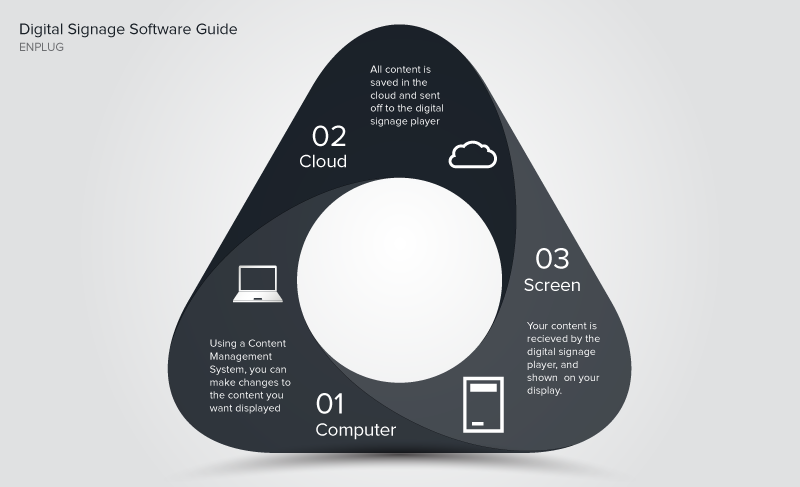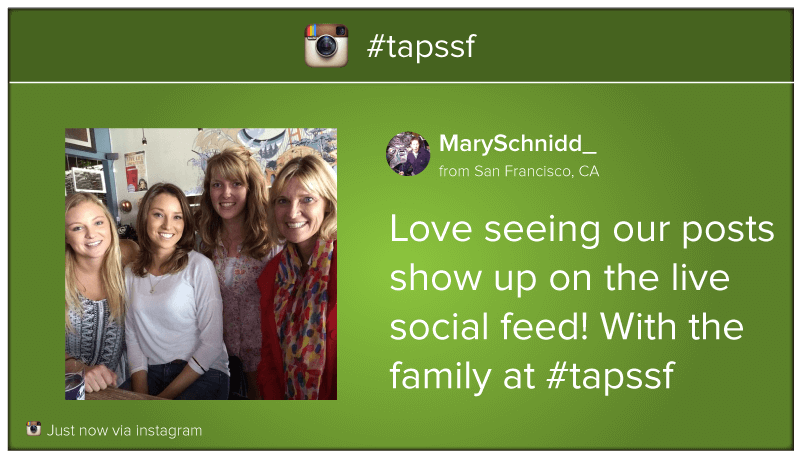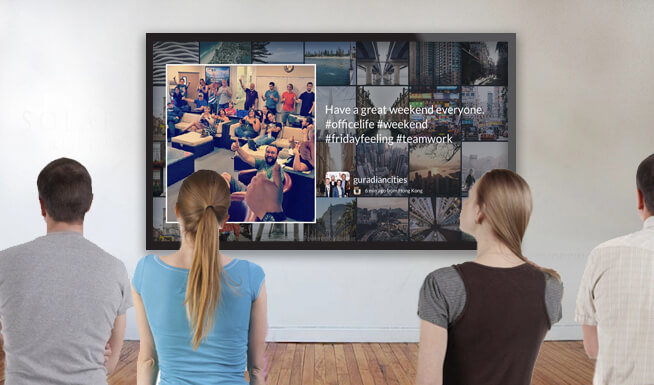
To survive in today’s fast-paced world, companies need to do two things well:
- Sell more products and services by engaging with customers
- Increase employee productivity by connecting the workplace
Effective use of digital signage can enable companies to achieve these twin goals.
What is digital signage?
Digital signage is a type of sign that is displayed using a TV screen or projection device. Instead of a physical print like a poster sign or a painted billboard, digital signage displays images digitally on a screen like a flat panel display or LED screen.
The advantage of digital signage comes from being able to quickly change content. Since it is digital, images can be changed instantly. You don’t need to wait for a new construction or installation as you would a plastic laser cut sign. Digital signage can offer moving images, which creates eye catching visuals making it very effective in grabbing a customer’s attention.
Digital signage usually consists of a digital signage player, which plugs into a TV screen. The player has digital signage software that is used to control the display of content. A user can upload images, videos, or create their own templates with the digital signage software.
Cloud digital signage software streams content on TV screens in one physical location or across multiple locations (even around the globe). Content can vary from shared social media walls to RSS news feeds to company videos to employee internal communications — all displaying on large TV screens.
Digital signage solutions are used by many corporations throughout their offices. Screens often display things like sales metrics and other KPIS in order to keep their employees constantly updated. Human resources departments often display work anniversaries and benefits calendars to improve employee engagement. Manufacturers have digital signage on their factory floors to keep track of takt times and scrap rates. The best digital signage software is able to be flexible and powerful enough to handle all these tasks in a single package.
Digital signage is one of the most effective ways to communicate with targeted audiences, reaching more viewers than Facebook or Internet ads.
As Irfan Khan says in the Sixteen Nine article “18 Surprising Statistics About Digital Signage”:
Digital media in public venues reach more customers than videos on the Internet or Facebook.
According to a 2010 study by Arbitron, digital signs reach an astounding number of Americans: 70 percent have seen a digital video display in the past month, versus 43 percent on the Internet or 41 percent on Facebook.
Digital signage enables companies to powerfully get their messages in front of their external and internal audiences. These targeted messages can be updated instantly anywhere via a wifi connection.

Sell more products and services by engaging with customers
Perhaps you want to showcase sales promotions in your brick-and-mortar retail stores. Or maybe you want to entertain fans waiting for their hand-made ice cream. You can also provide calming content for patients in medical practice waiting rooms. Whatever you want to share, digital signage can be your best friend.
1) Encourage engagement with your brand (social media, share story of company, products)
Social media walls available via digital signage enable fans to share their enthusiasm of your brand with others. In one example, a Toyota dealership implemented social media walls on its digital signage and saw a 14% increase in Twitter followers, 33% in Yelp reviews, and 65% increase in Instagram posts within 60 days.
Hector Cabral, Executive Director of Inka Franchise Corp, says:
Both customers and staff love seeing their posts on the screen along with posts from other locations, helping to link our brand across our nationwide locations.

Digital signage is particularly good for franchisors to engage customers in consistent messaging. The marketing team can deploy promotions and content across hundreds of locations in just a few clicks.
2) Customer experience — engagement and information
Engagement: Digital signage can add engagement to the customer experience. For example, take a restaurant that is currently displaying only sports and news on its large TV screens. Now imagine digital signage-enabled TVs that display an engaging selection of social media walls, digital menus, specials, and much more to enhance the restaurant customer experience.
Jake Sorofman of Gartner says in an article:
A recent Gartner survey on the role of marketing in customer experience found that, by 2016, 89% of companies expect to compete mostly on the basis of customer experience, versus 36% four years ago.
Information: Digital signage can also be used to clarify information for customers. For example, want to highlight where the check-out counters are in your retail stores? Use large TV screens over the counters to indicate location (and for added value you can highlight the day’s specials).
3) Share consistent marketing messages across locations
Companies with multiple locations want to ensure that their external messaging is consistent. Digital signage delivers this consistency.
Michael Fitzimmons, Brand Strategy Manager for WeWork, says:
WeWork has locations across different countries. We show live updates on our TV displays in every space to share all the exciting news from our community.
Use creative digital signage to captivate different captive audiences such as those people waiting for a concert to begin or at a check-out. Share a mix of entertainment and information content.

Increase employee productivity by connecting the workplace
Employees are more productive when they are tuned into a company’s mission and goals. Digital signage is a very powerful tool for connecting employees, especially across multiple locations.
Colin Bovet says in an article about internal communications ideas:
Whether you’re the head of culture at a tech startup or a manager at a Fortune 500 company, you should care deeply about how you communicate with your team.
Here are three employee communication areas in which digital signage can help connect the workplace:
1) Getting employees’ attention
How many of your company emails do your employees open each day? Cassie Paton’s post “7 Surprising Stats That Show the Importance of Internal Communications” notes how many employees never open their internal company emails:
In a survey by Prescient Digital Media, only 13% of employees reported participating in their intranet daily—31% said they never do.
Digital signage can connect your locations around the globe to improve sharing company information and thus increase productivity. When all employees are on the same page (or in this case, screen), there is less time-wasting miscommunication.
This same post says:
The McKinsey Global Institute found that productivity improves by 20-25% in organizations with connected employees. That kind of increase in productivity has potential for revenues amounting to $1.3 trillion per year.
Connecting your employees can be very good for your company’s bottom line.
2) Connect employees with company culture (across multiple offices)
If you are a franchisor or a company with multiple locations, ensuring consistent internal messaging can be a very productive use of digital signage.
Belén Alemán, Learning & Development Program Manager at Meltwater, describes her experience with digital signage:
I wanted to visually connect all of our offices in an easy and fun way. It’s important for all employees to feel included in what’s happening around the company and be able to see these updates in real-time. Ideally, I wanted to be able to promote our culture and values, our external blog, and also showcase important company and sales metrics.
Encouraging employees to share their user generated content via digital signage can help employees feel more a part of enterprise internal communications.
3) Provide ongoing training for employees
Using digital signage for ongoing training can connect employees in far-flung locations and ensure consistent training. For example, no need to worry that employees did not read the latest safety emailed memos when that safety information is attractively displayed across large TV display screens.
In addition, using digital signage to recognize company goal achievements can motivate future performances. Making employees stand out from their peers can be very encouraging to those employees not yet recognized.
Who uses digital signage software?
Digital signage software is used from small businesses to events to large franchises:
- Office digital signage
- Retail digital signage
- Restaurant digital signage
- Hotel digital signage
- School digital signage
- Real estate digital signage
- Event digital signage
Click here to read case studies of businesses using digital signage for internal and external communications.
What are the benefits of digital signage compared to traditional signage?
There are many benefits to upgrading from traditional signage to digital signage:
Cost effective
Unlike traditional signage, you can easily change and update your digital signage content at no additional cost.
Efficient
Being able to update your display’s content with the click of a button is both easy and time-saving.
Entertaining
Digital signage software enhances the customer experience via engaging content such as videos and more.
Informative
Digital signage is an easy way to inform people with fresh, relevant content whether it’s a company using digital signage for internal communications or a business using it for external communications with customers.
Advertising platform
Digital signage provides a highly effective medium for advertising and upselling.
Branding
Through digital signage you can bring elements of the web, such as social media, into the physical world. Digital signage is also a great tool to provide consistency among your locations.
Your competitors are already using digital signage
If your competitors are not yet using digital signage, they soon will be. Your company can be in the forefront of utilizing the power of digital signage.
Nanxi Liu says in an article:
According to a June 2016 report by Markets and Markets, the digital signage market was valued at $16.88 billion in 2015 and is expected to reach $27.34 billion by 2022.
With this type of growth, your company should hop on the bandwagon before getting left behind in the dust.
Easy to get started with digital signage software
If you have TV screens in your locations, you’re almost ready to go.
A cloud-based digital signage software company supplies a device to attach to each of your TV screens, and one person can control the content across multiple screens and multiple locations.
More full featured digital signage companies will have software that includes built-in digital signage templates so that you can quickly product great looking content. Common themes for the templates are around safety (for manufacturing), employee engagement, events, healthcare, restaurants, marketing, and holidays.
And where does the content come from?
Some of the content such as RSS news feeds may already be available in the web-based dashboard while other content can be created with easy-to-use apps or integrations. You can be as creative as you want with sharing graphics, video, social media updates, RSS news feeds, and more. Enplug offers integrations to popular services like Instagram, Slack, and Zoom. There is also a lot of automated content like health tips and motivational quotes that can add to your workplace culture.
In conclusion, the answer to the question “why use digital signage” is clear — your company’s bottom line can greatly benefits. Not only is digital signage good for marketing, it is great for internal communications. Its very visual nature can help emphasize initiatives around employee experience. Use it to affect change if there are any company culture initiatives. Use digital signage to augment other communication channels like the company intranet or email.